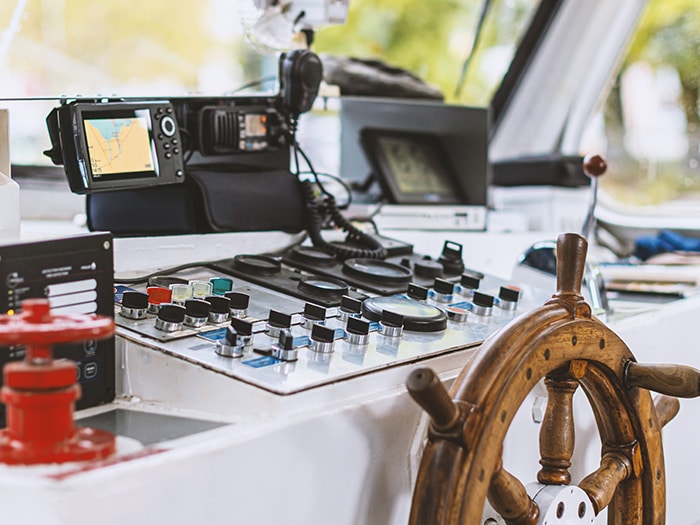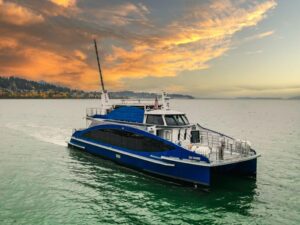
Op-Ed: Aeration control in hydraulic steering
Written by
Credit: Shutterstock
By Steve Warnock, VP of Engineering & Technical Support, and Matt Grussing, Regional Sales Director, both of Bailey International
Hydraulic steering systems often face a persistent and destructive enemy: aeration.
The following strategies can provide lasting solutions to aeration in marine hydraulic steering gears and will help you set a new standard for seafaring safety and reliability.
The Unseen Peril of Aeration
Aeration occurs when air infiltrates the hydraulic fluid, leading to many problems within a vessel’s steering system. The symptoms are varied but unmistakable—erratic movements of the rudder, increased steering effort, a “jerking” effect and in the worst cases, complete loss of steering. Aeration also promotes corrosion and accelerated wear in system components, causing a domino effect of pump cavitation, maintenance headaches and operational hazards.
Traditionally, aeration was combated through methods like system bleeding and reservoir placement, but these reactive approaches are no longer sufficient. We now know that pre-emptive measures are paramount, especially given the larger vessels and more complex systems in operation today. To tackle this, we’ve developed proactive strategies that harmonize with the hydraulic system rather than simply reacting to disturbance.
Proactive System Design for Aeration Avoidance
Our approach begins with a specific design strategy that minimizes the potential for air ingress. With thorough attention to detail, our engineers construct systems with optimized component placement and pipeline routing. These designs preclude air traps and dead zones. A comprehensive understanding of fluid dynamics allows teams to fine-tune pump and reservoir configurations to prevent air intrusion, maintaining the hydraulic circuit’s integrity even in the most demanding conditions.
Every component—from seals to hoses, pump inlets to rudder actuators—is selected and installed with the express purpose of aeration control in mind. These steering systems are designed to function as a closed loop.
Cutting-Edge Materials and Technologies
We also encourage our maritime customers to embrace innovative materials and technologies that outperform traditional options. For example, high-performance hydraulic oil with superior anti-foaming and de-aeration properties is a game-changer along with many forms of lubricant additives, reducing the formation and retention of air bubbles within the fluid. Couple this with air-removing devices strategically placed within the system, and you’ll see substantial reductions in aeration-related issues. These devices include, but are not limited to:
1. Reservoir Baffles and Diffusers
By incorporating baffles and diffusers within the hydraulic reservoir, you can effectively slow down the fluid velocity. This deceleration of the fluid allows air bubbles, which may have been introduced during operation, to rise to the surface more easily and escape. Also, baffles can help reduce turbulence within the reservoir, further promoting the separation of air from the hydraulic fluid. This entire process contributes to maintaining the efficiency and longevity of the hydraulic system.
2. Automatic Air Eliminators
These devices automatically detect and expel air from the system, ensuring smooth and efficient operation. They are commonly placed at system high points, around bends, and near critical components like pumps and actuators to prevent air pockets that could disrupt functionality. By removing trapped air, these devices help maintain optimal performance and extend the lifespan of the system, reducing the need for maintenance and preventing potential damage.
3. Hydraulic Accumulators with Air Separation Capability
Certain types of accumulators are specifically designed to separate and collect air, which can then be vented out of the system. These accumulators work by allowing air bubbles to rise and accumulate in a dedicated chamber, where they can be efficiently removed. Placing these accumulators at strategic points within a hydraulic or pneumatic system helps maintain consistent system pressure, reduce aeration, and improve overall efficiency. This ensures smoother operation and extends the lifespan of the components by minimizing the risk of air-induced damage.
Strategic Placement Tips:
- High Points: Installing air removal devices at high points in the system naturally aids in capturing rising air bubbles.
- Return Lines: Positioning devices in return lines leverages the lower pressure areas for more effective air removal.
- Near Pumps: Placing air removal devices close to pumps can prevent cavitation and improve pump performance.
- Reservoirs: Enhancing reservoir design with air removal features ensures that air is effectively separated before recirculating.
Integrating these devices and positioning them strategically within your maritime hydraulic system can noticeably enhance overall performance.
Additionally, the industry’s exploration of innovative materials has led to the adoption of advanced elastomers and seals that resist aeration-induced degradation. These components, such as fluorocarbon and silicone seals, maintain their integrity even with a high ratio of air to hydraulic fluid, ensuring longevity in aeration-prone conditions like power steering and braking systems.
The Future of Aeration Control in the Maritime Sector
Through relentless commitment to research and development, hydraulic component engineers are charting a course to a future where aeration is no longer a concern for marine systems. With proactive design, innovative materials, and the integration of state-of-the-art technologies, we are helping commercial vessels to maintain optimal steering performance.




